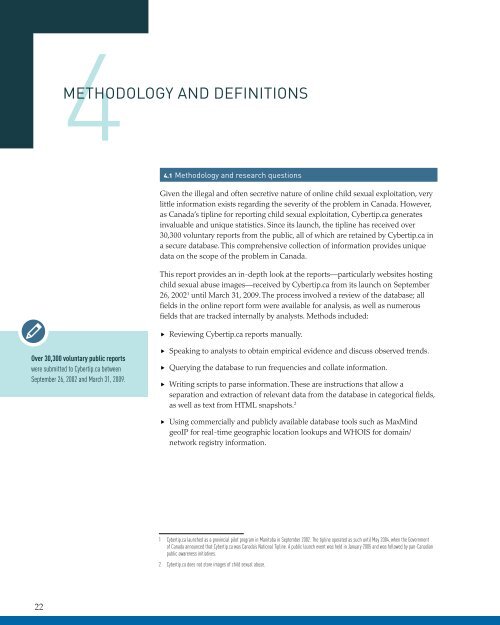Child Sexual AbuSe ImageS - Canadian Centre for Child Protection
Child Sexual AbuSe ImageS - Canadian Centre for Child Protection
Child Sexual AbuSe ImageS - Canadian Centre for Child Protection
You also want an ePaper? Increase the reach of your titles
YUMPU automatically turns print PDFs into web optimized ePapers that Google loves.
4mEThOdOLOgY ANd dEFiNiTiONS<br />
Overf30,300fvoluntaryfpublicfreportsf<br />
were submitted to Cybertip.ca between<br />
September 26, 2002 and March 31, 2009.<br />
4.1 methodology and research questions<br />
Given the illegal and often secretive nature of online child sexual exploitation, very<br />
little in<strong>for</strong>mation exists regarding the severity of the problem in Canada. However,<br />
as Canada’s tipline <strong>for</strong> reporting child sexual exploitation, Cybertip.ca generates<br />
invaluable and unique statistics. Since its launch, the tipline has received over<br />
30,300 voluntary reports from the public, all of which are retained by Cybertip.ca in<br />
a secure database. This comprehensive collection of in<strong>for</strong>mation provides unique<br />
data on the scope of the problem in Canada.<br />
This report provides an in-depth look at the reports—particularly websites hosting<br />
child sexual abuse images—received by Cybertip.ca from its launch on September<br />
26, 2002 1 until March 31, 2009. The process involved a review of the database; all<br />
fields in the online report <strong>for</strong>m were available <strong>for</strong> analysis, as well as numerous<br />
fields that are tracked internally by analysts. Methods included:<br />
ff Reviewing Cybertip.ca reports manually.<br />
ff Speaking to analysts to obtain empirical evidence and discuss observed trends.<br />
ff Querying the database to run frequencies and collate in<strong>for</strong>mation.<br />
ff Writing scripts to parse in<strong>for</strong>mation. These are instructions that allow a<br />
separation and extraction of relevant data from the database in categorical fields,<br />
as well as text from HTML snapshots. 2<br />
ff Using commercially and publicly available database tools such as MaxMind<br />
geoIP <strong>for</strong> real-time geographic location lookups and WHOIS <strong>for</strong> domain/<br />
network registry in<strong>for</strong>mation.<br />
1 Cybertip.ca launched as a provincial pilot program in Manitoba in September 2002. The tipline operated as such until May 2004, when the Government<br />
of Canada announced that Cybertip.ca was Canada’s National Tipline. A public launch event was held in January 2005 and was followed by pan-<strong>Canadian</strong><br />
public awareness initiatives.<br />
2 Cybertip.ca does not store images of child sexual abuse.<br />
The Cybertip.ca database is redefined and upgraded on an ongoing basis; as new<br />
trends are identified, classifications are expanded or changed. On April 14, 2008, a<br />
major redesign of the database was launched. This new system, which automates<br />
a number of analyst tasks, also simplifies modifications to the database. This<br />
means that since April 2008, the number of fields being tracked by Cybertip.ca has<br />
increased significantly. As a result of these ongoing improvements, total numbers,<br />
as well as the time periods in which items were analyzed, may vary.<br />
Consequently, in some instances, sample sizes may be small. In these instances, we<br />
do not intend <strong>for</strong> the results to show statistical validity, but rather possible patterns<br />
and trends in need of further inquiry. These fields will be followed closely over the<br />
upcoming years to watch <strong>for</strong> changing trends and create more robust data.<br />
INITIAl ReSeARCH queSTIONS<br />
1 How many websites hosting child abuse material have been reported to<br />
Cybertip.ca and what do these websites look like?<br />
2 What is the age of victims on websites hosting child sexual abuse<br />
images and are they more likely to be images of girl or boy children?<br />
3 What is the degree of abuse being depicted against the child, as<br />
assessed by the analyst image severity classification?<br />
4 Can we track the geographic location of websites, including where illegal<br />
content is most likely to be hosted and how it moves between locations?<br />
5 What can we learn about child sexual abuse by looking at the content of<br />
websites that host images (layout, text, content, title bars, etc.)?<br />
6 Is there a difference between commercial child abuse websites and<br />
those that are available free of charge?<br />
In some instances, sample sizes may be small. In these instances, we do not<br />
intend <strong>for</strong> the results to show statistical validity, but rather possible patterns<br />
and trends in need of further inquiry.<br />
22 mEThOdOLOgY ANd dEFiNiTiONS 23


